Abstract
Purpose
Methods
Results
Conclusion
Figures and Tables
Fig. 1

Table 2
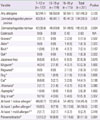
Values are presented as number (%).
NA, not available.
*Fisher's exact test. †Indoor allergens include D. pteronyssinus, D. farinae, cockroach, dog, and cat. ‡Pollen allergens include grass, alder, birch, oak, Japanese hop, mugwort, and ragweed. §Mold allergens include Alternaria and Aspergillus. ∥More than two sensitizations on skin prick test.
Table 3
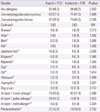
Values are presented as number (%).
NA, not available.
*Fisher's exact test. †Indoor allergens include D. pteronyssinus, D. farinae, cockroach, dog, and cat. ‡Pollen allergens include grass, alder, birch, oak, Japanese hop, mugwort, and ragweed. §Mold allergens include Alternaria and Aspergillus. ∥More than two sensitizations on skin prick test.
Table 4
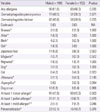
Values are presented as number (%).
NA, not available.
*Fisher's exact test. †Indoor allergens include D. pteronyssinus, D. farinae, cockroach, dog, and cat. ‡Pollen allergens include grass, alder, birch, oak, Japanese hop, mugwort, and ragweed. §Mold allergens include Alternaria and Aspergillus. ∥More than two sensitizations on skin prick test.
Table 5
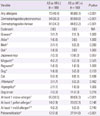
Values are presented as number (%).
AS, asthma; AR, allergic rhinitis; NA, not available.
*Fisher's exact test. †Indoor allergens include D. pteronyssinus, D. farinae, cockroach, dog, and cat. ‡Pollen allergens include grass, alder, birch, oak, Japanese hop, mugwort, and ragweed. §Mold allergens include Alternaria and Aspergillus. ∥More than two sensitizations on skin prick test.
Table 6

Data were calculated by logistic regression multivariate analysis.
aOR, adjusted by age, sex, body mass index, environmental tobacco smoke, monthly income, and history of parental asthma; OR, odds ratio; NA, not available.
*Indoor allergens include D. pteronyssinus, D. farinae, cockroach, dog, and cat. †Pollen allergens include grass, alder, birch, oak, Japanese hop, mugwort, and ragweed. ‡Mold allergens include Alternaria and Aspergillus. §More than two sensitizations on skin prick test.
Table 7

Data were calculated by logistic regression multivariate analysis.
OR, adjusted by age, sex, body mass index, environmental tobacco smoke, monthly income, and history of parental asthma; OR, odds ratio; NA, not available.
*Indoor allergens include D. pteronyssinus, D. farinae, cockroach, dog, and cat. †Pollen allergens include grass, alder, birch, oak, Japanese hop, mugwort, and ragweed. ‡Mold allergens include Alternaria and Aspergillus. §More than two sensitizations on skin prick test.
Table 8

Data were calculated by logistic regression multivariate analysis.
aOR, adjusted by age, sex, body mass index, environmental tobacco smoke, monthly income, and history of parental asthma; OR, odds ratio; NA, not available.
*Indoor allergens include D. pteronyssinus, D. farinae, cockroach, dog, and cat. †Pollen allergens include grass, alder, birch, oak, Japanese hop, mugwort, and ragweed. ‡Mold allergens include Alternaria and Aspergillus. §More than two sensitizations on skin prick test.




 PDF
PDF ePub
ePub Citation
Citation Print
Print


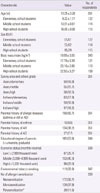
 XML Download
XML Download